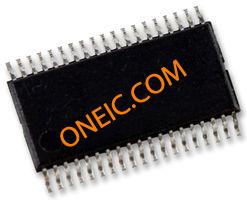SN65LVDS389DBTG4
Octal LVDS transmitters in 38-pin TSSOP for high-speed data transmission
Manufacturer: ti
series introduction
# SN65LVDS389DBTG4 Product Series Introduction
## 1. Overview
The SN65LVDS389DBTG4 belongs to a high - performance product series in the field of low - voltage differential signaling (LVDS) technology. LVDS is a widely used interface standard known for its high - speed data transmission, low power consumption, and excellent noise immunity. This product series is designed to meet the demanding requirements of modern electronic systems, such as high - definition displays, industrial automation, and communication equipment.
## 2. Key Features
### 2.1 High - Speed Data Transmission
- The SN65LVDS389DBTG4 is capable of supporting very high data rates. It can transmit data at speeds that are suitable for applications where large amounts of data need to be transferred quickly. For example, in high - definition video transmission, it can handle the high - bandwidth requirements of 1080p or even higher - resolution video signals, ensuring smooth and real - time display of content.
- The differential signaling scheme used in LVDS technology allows for reliable high - speed data transfer. The differential pairs in the SN65LVDS389DBTG4 can effectively reduce electromagnetic interference (EMI) and crosstalk, which are common issues in high - speed data transmission. This results in a clean and stable data signal, minimizing the error rate during transmission.
### 2.2 Low Power Consumption
- One of the significant advantages of the SN65LVDS389DBTG4 is its low power consumption. In today's energy - conscious world, reducing power consumption is crucial for both portable and non - portable electronic devices. The low power design of this product series helps to extend the battery life of portable devices and also reduces the overall power requirements of larger systems.
- The LVDS technology itself is inherently power - efficient. The SN65LVDS389DBTG4 further optimizes power consumption through its internal circuit design, such as using low - voltage operation and efficient power management techniques.
### 2.3 Noise Immunity
- The differential signaling in the SN65LVDS389DBTG4 provides excellent noise immunity. External noise sources, such as electromagnetic interference from nearby components or power supplies, have a minimal impact on the differential signal. The receiver in the SN65LVDS389DBTG4 compares the voltage difference between the two differential lines, effectively canceling out common - mode noise.
- This noise immunity makes the SN65LVDS389DBTG4 suitable for use in harsh electrical environments, such as industrial settings where there are many sources of electrical noise. It ensures the integrity of the data being transmitted, even in the presence of significant interference.
### 2.4 Small Form Factor
- The SN65LVDS389DBTG4 is available in a small form - factor package, such as the DBTG4 package. This small size makes it easy to integrate into compact electronic devices. It saves valuable board space, which is especially important in applications where space is limited, such as mobile devices, laptops, and small - sized industrial control modules.
## 3. Functional Block Diagram and Working Principle
### 3.1 Transmitter Section
- The transmitter in the SN65LVDS389DBTG4 takes the parallel data input from the source device. It then encodes this parallel data into a differential LVDS signal. The encoding process may involve techniques such as 8B/10B encoding to ensure DC balance and proper clock recovery at the receiver end.
- The differential LVDS signal is then transmitted over a pair of twisted - pair wires or a differential trace on a printed circuit board. The transmitter is designed to drive the differential signal with sufficient amplitude and slew rate to ensure
Images for reference

38-TSSOP

Image Preview

Image Preview